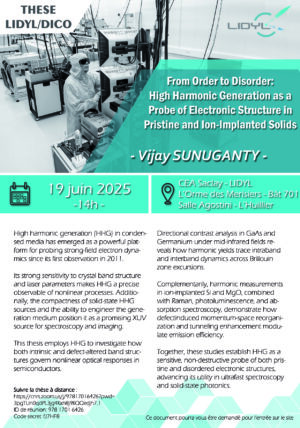
From Order to Disorder: High Harmonic Generation as a Probe of Electronic Structure in Pristine and Ion-Implanted Solids
High harmonic generation (HHG) in condensed media has emerged as a powerful platform for probing strong-field electron dynamics since its first observation in 2011. Its strong sensitivity to crystal band structure and laser parameters makes HHG a precise observable of nonlinear processes.
Additionally, the compactness of solid-state HHG sources and the ability to engineer the generation medium position it as a promising XUV source for spectroscopy and imaging. This thesis employs HHG to investigate how both intrinsic and defect-altered band structures govern nonlinear optical responses in semiconductors.
Directional contrast analysis in GaAs and Germanium under mid-infrared fields reveals how harmonic yields trace intraband and interband dynamics across Brillouin zone excursions. Complementarily, harmonic measurements in ion-implanted Si and MgO, combined with Raman, photoluminescence, and absorption spectroscopy, demonstrate how defect induced momentum-space reorganization and tunneling enhancement modulate emission efficiency.
Together, these studies establish HHG as a sensitive, non-destructive probe of both pristine and disordered electronic structures, advancing its utility in ultrafast spectroscopy and solid-state photonics


